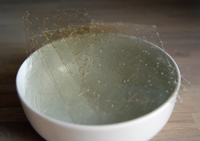
Photo from wikipedia
The architectural and physiomechanical properties of regenerative scaffolds have been shown to improve engineered tissue function at both a cellular and tissue level. The fabrication of regenerative three-dimensional scaffolds that… Click to show full abstract
The architectural and physiomechanical properties of regenerative scaffolds have been shown to improve engineered tissue function at both a cellular and tissue level. The fabrication of regenerative three-dimensional scaffolds that precisely replicate the complex hierarchical structure of native tissue, however, remains a challenge. The aim of this work is therefore two-fold: i) demonstrate an innovative multidirectional freeze-casting system to afford precise architectural control of ice-templated collagen scaffolds; and ii) present a predictive simulation as an experimental design tool for bespoke scaffold architecture. We used embedded heat sources within the freeze-casting mold to manipulate the local thermal environment during solidification of ice-templated collagen scaffolds. The resultant scaffolds comprised complex and spatially varied lamellar orientations that correlated with the imposed thermal environment and could be readily controlled by varying the geometry and power of the heat sources. The complex macro-architecture did not interrupt the hierarchical features characteristic of ice-templated scaffolds, but pore orientation had a significant impact on the stiffness of resultant structures under compression. Furthermore, our finite element model (FEM) accurately predicted the thermal environment and illustrated the freezing front topography within the mold during solidification. The lamellar orientation of freeze-cast scaffolds was also predicted using thermal gradient vector direction immediately prior to phase change. In combination our FEM and bespoke freeze-casting system present an exciting opportunity for tailored architectural design of ice-templated regenerative scaffolds that mimic the complex hierarchical environment of the native extracellular matrix. STATEMENT OF SIGNIFICANCE: Biomimetic scaffold structure improves engineered tissue function, but the fabrication of three-dimensional scaffolds that precisely replicate the complex hierarchical structure of native tissue remains a challenge. Here, we leverage the robust relationship between thermal gradients and lamellar orientation of ice-templated collagen scaffolds to develop a multidirectional freeze-casting system with precise control of the thermal environment and consequently the complex lamellar structure of resultant scaffolds. Demonstrating the diversity of our approach, we identify heat source geometry and power as control parameters for complex lamellar orientations. We simultaneously present a finite element model (FEM) that describes the three-dimensional thermal environment during solidification and accurately predicts lamellar structure of resultant scaffolds. The model serves as a design tool for bespoke regenerative scaffolds.
Journal Title: Acta biomaterialia
Year Published: 2022
Link to full text (if available)
Share on Social Media: Sign Up to like & get
recommendations!